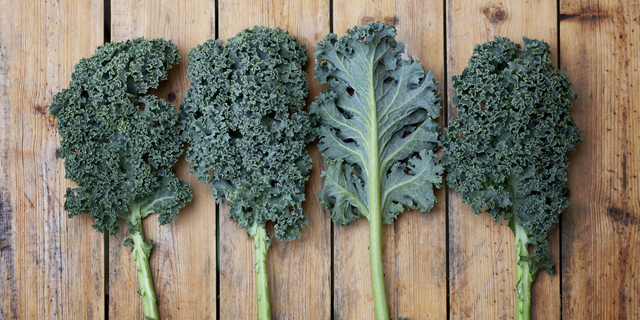Whether it’s bright green or purple, curly or dino, kale is known as a nutritional powerhouse for good reason! Rich in Vitamin A, Vitamin C, potassium, and Vitamin K, kale supports your body, mind, and heart. Also a good source of iron, manganese, and copper, at 33 calories per cup and bursting with a slew of anti-inflammatory nutrients and antioxidants it’s no wonder it’s so popular. From kale chips to kale juices, this delicious and nutritious green should be your new best friend with health benefits!
How do I pick the best kale?
There are three main types of kale. Dinosaur kale, known as Lacinto or Tuscan kale, has forest green-bluish leaves that are heartier with a more delicate taste. Ornamental kale can have purple, red, white, or green leaves, and is more tender than the dino variety. Curly kale has leaves that ruffle at the edges, with a deep and bright green color and a more robust, peppery flavor. Regardless of the type, the freshest kale is available from early winter until spring. Look for rich colored leaves that are firm with crisp stems. Skip bunches that have yellowing or slimy leaves, as well as flimsy stalks. Choose baby kale greens for smoothies, which are sweeter, more tender and have a milder flavor. Varieties with larger leaves are best for baked chips and braises, since they are heartier and can stand up to the heat.
What can I make with kale?
Kale is a powerhouse ingredient and because of it’s nutritional density should be thrown into every dish possible. Enjoy a lean, mean, green kale smoothie for breakfast or add a handful of baby kale to your morning scramble. Add kale leaves to your turkey sandwich or make a batch of baked Aji Kale Chips and snack on them all day long. For dinner have a side of braised kale, a bowl of Kale and White Bean Soup with Spicy Chorizo Meatballs or make a kale chimichurri and spoon it over a grilled steak. You can even boost your favorite fudge brownies with steamed and pureed kale, making that second serving a necessary one since your brownies are more healthy!
Preparation often involves removing the leaves from the stalks. Stalks can be used for stocks or given as a treat to your pup. That’s right, kale is great for you and for your dog too! As with most greens, only wash right before using. Then chop and tear as needed. And storage? Kale will keep fresh and bright in the refrigerator crisper for 2-3 days. To freeze, blanch clean leaves, cool completely, towel dry, and pack in a tightly sealed ziplock bag. Frozen blanched kale will last up to twelve months, so stock up while the pickings are fresh!
Recipes to try include: Mini Chimichurri Kale Pizza, Sopa Verde Picante, and Chorizo and Vegetable Stuffed Delicata Squash.
Inspired to get in the kitchen? Try this Kale and Squash Gratin.
- 2 tablespoons avocado oil
- 1 teaspoon salt
- 1 teaspoon black pepper
- 1 medium butternut squash
- 1 tablespoon olive oil
- 2 cups chopped kale
- 3 cloves garlic, minced
- 1/4 cup raisins
- 3/4 cup breadcrumbs
- 1/2 cup shredded mozzarella cheese



![Making Mealtime Matter with La Familia: Easy Sofrito [Video]](https://thelatinkitchen.com/wp-content/uploads/2015/10/sofrito-shutterstock__0-500x383.jpg)
![Easy Latin Smoothies: Goji Berry Smoothie [Video]](https://thelatinkitchen.com/wp-content/uploads/2015/12/goji_berry-shutterstock_-500x383.jpg)
















![Fun and Fast Recipes: Fiesta Cabbage Salad [Video]](https://thelatinkitchen.com/wp-content/uploads/2015/11/fiesta_cabbage_slaw-shutterstock_-500x383.jpg)









